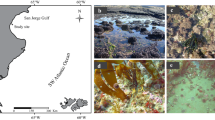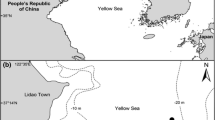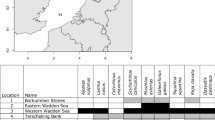Abstract
Although chondrichthyans are conspicuously present in shallow waters, many ecological aspects of neritic species in the Humboldt Current System remain unknown. This study provides a first assessment of the diet of seven commercially exploited and understudied sympatric chondrichthyans inhabiting nearshore habitats off the central coast of Peru: four stingrays (Hypanus dipterurus, Myliobatis peruvianus, M. chilensis, and Urotrygon chilensis), a guitarfish (Pseudobatos planiceps), a smooth-hound shark (Mustelus mento), and a chimaera (Callorhinchus callorynchus). A total of 166 stomachs were examined between 2012 and 2015 and prey items were pooled for the total of years for analysis. Although our analysis did not account for inter seasons variability, our results suggest diet partitioning among species, except for the stingrays’ group. A diet based on soft-bottom polychaetes and fish was shared by H. dipterurus, M. peruvianus, and M. chilensis, while soft-bottom polychaetes and crabs were more important in U. chilensis. The smooth-hound shark and guitarfish exhibited a diet dominated by crabs, and the chimaera consumed mainly hard-bottom mollusks. Foraging habitat estimations distinguished two main habitats of association: Benthic, including the stingray U. chilensis, the chimaera, and the smooth-hound shark; and benthic-demersal, including the guitarfish, and the rest of stingrays. A pattern of feeding specialization was observed for H. dipterurus, P. planiceps, and C. callorynchus. Preliminary trophic level estimations based on diet composition placed these species as secondary consumers. Intraspecific dietary variation was assessed for P. planiceps and H. dipterurus as their sampled sizes allowed meaningful comparisons. The diet of P. planiceps varied from small to large sizes but not for H. dipterurus. No differences were detected on diet composition between males and females in either species. Despite the limited temporal resolution, this study provides the first insights of chondrichthyans predatory activity, suggesting diet partitioning among the species of this assemblage in a nearshore habitat of the central coast of Peru. Enhancing the temporal resolution of this type of studies would improve our knowledge on trophic functioning in the Humboldt Current ecosystem.



Similar content being viewed by others
References
Amariles DF, Navia AF, Giraldo A (2017) Food resource partitioning of the Mustelus lunulatus and Mustelus henlei (Elasmobranchii: Carcharhiniformes). Environ Biol Fish 100:717–732. https://doi.org/10.1007/s10641-017-0598-x
Anderson MJ (2001) A new method for non-parametric multivariate analysis of variance. Austral Ecol 26:32–46. https://doi.org/10.1111/j.1442-9993.2001.01070.pp.x
Bizzarro JJ (2005) Fishery biology and feeding ecology of rays in Bahía Almejas, Mexico. M.S. Thesis. California State University, Moss Landing Marine Lab, San Francisco
Bizzarro JJ, Robinson HJ, Rinewalt CS, Ebert DA (2007) Comparative feeding ecology of four sympatric skate species off Central California, USA. Environ Biol Fish 80:197–220. https://doi.org/10.1007/s10641-007-9241-6
Bizzarro JJ, Yoklavich MM, Wakefield WW (2017) Diet composition and foraging ecology of U.S. Pacific coast groundfishes with applications for fisheries management. Environ Biol Fish 100:375–393. https://doi.org/10.1007/s10641-016-0529-2
Blaber SJM, Cyrus DP, Albaret JJ, Ching CV, Day JW, Elliott M, Fonseca MS, Hoss DE, Orensanz J, Potter IC, Silvert W (2000) Effects of fishing on the structure and functioning of estuarine and nearshore ecosystems. ICES J Mar Sci 57:590–602. https://doi.org/10.1006/jmsc.2000.0723
Blanco-Parra MP, Galván-Magaña F, Márquez-Farías JF, Niño-Torres CA (2012) Feeding ecology and trophic level of the banded guitarfish, Zapteryx exasperata, inferred from stable isotopes and stomach contents analysis. Environ Biol Fish 95:65–77. https://doi.org/10.1007/s10641-011-9862-7
Brown SC, Bizzarro JJ, Cailliet GM, Ebert DA (2012) Breaking with tradition: redefining measures for diet description with a case study of the Aleutian skate Bathyraja aleutica (Gilbert 1896). Environ Biol Fish 95:3–20. https://doi.org/10.1007/s10641-011-9959-z
Carlson JK, Goldman KJ, Lowe CG (2004) Metabolism, energetic demand, and endothermy. In: Carrier JC, Musick JA, Heithaus MR (eds) Biology of sharks and their relatives, 2nd edn. CRC Press, Boca Raton, pp 269–286
Castañeda J (1994) La pesquería artesanal y biología pesquería de especies de importancia económica en caleta San José, Lambayeque-Perú (febrero 1991-septiembre 1992). Tesis de Biología. Universidad Nacional Mayor de San Marcos, pp 23–36
Clarke KR, Gorley RN (2015) PRIMER v7: User Manual/Tutorial. PRIMER-E, Plymouth, UK
Clarke KR, Gorley RN, Sommerfield PJ, Warwick RM (2014) Change in marine communities: an approach to statistical analysis and interpretation, 3rd edn. Primer-E, Plymouth
Clench HK (1979) How to make regional lists of butterflies: some thoughts. J Lepid Soc 33:216–231
Cornejo R, Vélez-Zuazo X, González-Pestana A, Kouri JC, Mucientes G (2015) An updated checklist of Chondrichthyes from the Southeast Pacific off Peru. Check list 11:1809. https://doi.org/10.15560/11.6.1809
Cortés E (1999) Standardized diet compositions and trophic levels of sharks. ICES J Mar Sci 56:707–717. https://doi.org/10.1006/jmsc.1999.0489
De la Rosa-Meza K (2010) Ecomorfología mandibular y dietas de batoideos en el Golfo de California. Ph.D. Thesis. Centro de Investigaciones Científicas y de Educación Superior de Ensenada. BC México, pp 1–308
De la Rosa-Meza K, Sosa-Nishizaki O, de la Cueva-Salcedo H (2013) Feeding habits of the speckled guitarfish Rhinobatos glaucostigma (Elasmobranchii, Batoidea) in the southeastern gulf of California. Cienc Mar 39:277–290. https://doi.org/10.7773/cm.v39i3.2229
Di Giacomo EE, Perier MR (1996) Feeding habits of cockfish, Callorhinchus callorhynchus (Holocephali: Callorhynchidae), in Patagonian waters (Argentina). Mar Freshw Res 47:801–808. https://doi.org/10.1071/MF9960801
Dulvy NK, Fowler SL, Musick JA, Cavanagh RD, Kyne PM, Harrison LR, Carlson JK, Davidson LNK, Fordham SV, Francis MP, Pollock CM, Simpfendorfer CA, Burgess GH, Carpenter KE, Compagno LJV, Ebert DA, Gibson C, Heupel MR, Livingstone SR, Sanciangco JC, Stevens JD, Valenti S, White WT (2014) Extinction risk and conservation of the world’s sharks and rays. eLife 3:e00590. https://doi.org/10.7554/eLife.00590
Ebert DA, Bizzarro JJ (2007) Standardized diet compositions and trophic levels of skates (Chondrichthyes: Rajiformes: Rajoidei). Environ Biol Fish 80:221–237. https://doi.org/10.1007/s10641-007-9227-4
Espinoza M, Clarke TM, Villalobos-Rojas F, Wehrtmann IS (2012) Ontogenetic dietary shifts and feeding ecology of the rasptail skate Raja velezi and the brown smoothhound shark Mustelus henlei along the Pacific coast of Costa Rica, Central America. J Fish Biol 81:1578–1595. https://doi.org/10.1111/j.1095-8649.2012.03410.x
Espinoza M, Munroe SEM, Clarke TM, Fisk AT, Wehrtmann IS (2015) Feeding ecology of common demersal elasmobranch species in the Pacific coast of Costa Rica inferred from stable isotope and stomach content analyses. J Exp Mar Biol Ecol 470:12–25. https://doi.org/10.1016/j.jembe.2015.04.021
Ferry LA, Cailliet GM (1996) Sample size sufficiency and data analysis: are we characterizing and comparing diet properly? In: MacKinlay D, Shearer K (eds) Feeding ecology and nutrition in fish: proceedings of the symposium on the feeding ecology and nutrition in fish, international congress on the biology of fish, San Francisco, CA, 14–18 July 1996, pp 71–80
Flores-Ortega JR, Godínez-Domínguez E, González-Sansón G, Rojo-Vázquez JA, Corgos A, Morales-Jáuregui MY (2011) Feeding habits of three round stingrays (Rajiformes: Urotrygonidae) in the central Mexican Pacific. Cienc Mar 37:279–292. https://doi.org/10.7773/cm.v37i3.1871
Froese R, Pauly D (2016) FishBase. World Wide Web electronic publication. www.fishbase.org. Accessed 4 January 2018
Gonzalez-Pestana A, Kouri JC, Velez-Zuazo X (2016) Shark fisheries in the Southeast Pacific: a 61-year analysis from Peru. F1000Res 3:164. https://doi.org/10.12688/f1000research.4412.2
Grubbs RD, Carlson JK, Romine JG, Curtis TH, McElroy WD, McCandless CT, Cotton CF, Musick JA (2016) Critical assessment and ramifications of a purported marine trophic cascade. Sci Rep 6:20970. https://doi.org/10.1038/srep20970
Heemstra PC (1997) A review of the smooth-hound sharks (genus Mustelus, family Triakidae) of the western Atlantic Ocean, with descriptions of two new species and a new subspecies. Bull Mar Sci 60:894–928
Heithaus MR, Frid A, Vaudo JJ, Worm B, Wirsing AJ (2010) Unraveling the ecological importance of elasmobranchs. In: Carrier JC MJ, Heithaus MR (ed) Sharks and their relatives II. CRC Press: Boca Raton, pp 611–637
Heupel MR, Knip DM, Simpfendorfer CA, Dulvy NK (2014) Sizing up the ecological role of sharks as predators. Mar Ecol Prog Ser 495:291–298
Hyslop EJ (1980) Stomach contents analysis—a review of methods and their application. J Fish Biol 17:411–429. https://doi.org/10.1111/j.1095-8649.1980.tb02775.x
Jacobsen IP, Bennett MB (2013) A comparative analysis of feeding and trophic level ecology in stingrays (Rajiformes; Myliobatoidei) and electric rays (Rajiformes: Torpedinoidei). PLoS One 8:e71348. https://doi.org/10.1371/journal.pone.0071348
Jiménez-Valverde A, Hortal J (2003) Las curvas de acumulacion de especies y la necesidad de evaluar los inventarios biologicos. Revista Ibérica de Aracnología 8:151–161
Kemper JM, Bizzarro JJ, Ebert DA (2017) Dietary variability in two common Alaskan skates (Bathyraja interrupta and Raja rhina). Mar Biol 164:52. https://doi.org/10.1007/s00227-017-3078-0
Kolmann MA, Huber DR, Motta PJ, Grubbs RD (2015) Feeding biomechanics of the cownose ray, Rhinoptera bonasus, over ontogeny. J Anat 227:341–351. https://doi.org/10.1111/joa.12342
Krebs CJ (1999) Ecological methodology, 2nd edn. Harper and row publishers, New York, p 654
Lindeman RL (1942) The trophic-dynamic aspect of ecology. Ecology 23:399–417. https://doi.org/10.2307/1930126
López-García J, Navia AF, Mejía-Falla PA, Rubio EA (2012) Feeding habits and trophic ecology of Dasyatis longa (Elasmobranchii: Myliobatiformes): sexual, temporal and ontogenetic effects. J Fish Biol 80:1563–1579. https://doi.org/10.1111/j.1095-8649.2012.03239.x
Macdonald JS, Green RH (1983) Redundancy of variables used to describe importance of prey species in fish diets. Can J Fish Aquat Sci 40:635–637. https://doi.org/10.1139/f83-083
Myers RA, Baum JK, Shepherd TD, Powers SP, Peterson CH (2007) Cascading effects of the loss of apex predatory sharks from a coastal ocean. Science 315:1846–1850. https://doi.org/10.1126/science.1138657
Navarro-González J, Bohórquez-Herrera J, Navia A, Cruz-Escalona V (2012) Composición trófica de batoideos en la plataforma continental frente a Nayarit y Sinaloa, México. Cienc Mar 38:347–362
Navia AF, Mejía-Falla PA, Giraldo A (2007) Feeding ecology of elasmobranch fishes in coastal waters of the Colombian eastern tropical Pacific. BMC Ecol 7:8–8. https://doi.org/10.1186/1472-6785-7-8
Navia AF, Torres A, Mejía-Falla PA, Giraldo A (2011) Sexual, ontogenetic, temporal and spatial effects on the diet of Urotrygon rogersi (Elasmobranchii:Myliobatiformes). J Fish Biol 78:1213–1224. https://doi.org/10.1111/j.1095-8649.2011.02931.x
Ochoa N, Taylor MH, Purca S, Ramos E (2010) Intra- and interannual variability of nearshore phytoplankton biovolume and community changes in the northern Humboldt current system. J Plankton Res 32:843–855. https://doi.org/10.1093/plankt/fbq022
Pedraza M, Cubillos LA (2009) Hábitos alimentarios y dieta del pejegallo (Callorhinchus callorhynchus Linneaus, 1958) en la zona centro-sur de Chile (33°S a 41°S). In: XXIX Congreso de Ciencias del Mar, Concepción, 2009. Instituto de Investigación Pesquera, Concepción, p 203
Pinkas L, Oliphant M, Iverson L (1971) Food habits of albacore bluefin tuna and bonito in California waters. University of California. https://escholarship.org/uc/item/7t5868rd. Accessed 6 Jan 2018
Polo-Silva C, Grijalba-Bendeck M (2008) Espectro trófico de la raya guitarra Rhinobatos percellens (Walbaum, 1792)(Elasmobranchii: Rhinobatidae) en Santa Marta, Caribe Colombia. Mem Fund La Salle Cien Nat 169:21–33
Rojas P (2000) Contribución al conocimiento biológico de Mustelus lunulatus un recurso pesquero potencial en el Pacífico Colombiano. Tesis de Biología. Universidad del Valle, Cali, pp 1–59
Ross ST (1986) Resource partitioning in fish assemblages: a review of field studies. Copeia 1986:352–388. https://doi.org/10.2307/1444996
Sánchez-Hernández J, Vieira-Lanero R, Servia MJ, Cobo F (2011) Feeding habits of four sympatric fish species in the Iberian Peninsula: keys to understanding coexistence using prey traits. Hydrobiologia 667:119–132. https://doi.org/10.1007/s10750-011-0643-2
Smith WD, Cailliet GM, Melendez EM (2007) Maturity and growth characteristics of a commercially exploited stingray, Dasyatis dipterura. Mar Freshw Res 58:54–66. https://doi.org/10.1071/MF06083
Snelson FF, Williams-Hooper SE, Schmid TH (1988) Reproduction and ecology of the Atlantic stingray, Dasyatis sabina, in Florida coastal lagoons. Copeia 1988:729–739. https://doi.org/10.2307/1445395
StatSoft Inc (2006) Electronic statistics textbook. Statsoft, Tulsa
Tam J, Taylor MH, Blaskovic V, Espinoza P, Michael Ballón R, Díaz E, Wosnitza-Mendo C, Argüelles J, Purca S, Ayón P, Quipuzcoa L, Gutiérrez D, Goya E, Ochoa N, Wolff M (2008) Trophic modeling of the northern Humboldt current ecosystem, part I: comparing trophic linkages under La Niña and El Niño conditions. Prog Oceanogr 79:352–365. https://doi.org/10.1016/j.pocean.2008.10.007
Tarazona J, Gutiérrez D, Paredes C, Indacochea A (2003) Overview and challenges of marine biodiversity research in Peru. Gayana (Concepción) 67:206–231. https://doi.org/10.4067/S0717-65382003000200009
Taylor MH, Wolff M (2007) Trophic modeling of eastern boundary current systems: a review and prospectus for solving the" Peruvian puzzle". Rev Peru Biol 14:87–100
Taylor MH, Wolff M, Mendo J, Yamashiro C (2008) Changes in trophic flow structure of Independence Bay (Peru) over an ENSO cycle. Prog Oceanogr 79:336–351
Thrush SF, Pridmore RD, Hewitt JE, Cummings VJ (1994) The importance of predators on a sandflat: interplay between seasonal changes in prey densities and predator effects. Mar Ecol Prog Ser 107:211–222 http://www.jstor.org/stable/24842678
Tobin AJ, Mapleston A, Harry AV, Espinoza M (2014) Big fish in shallow water; use of an intertidal surf-zone habitat by large-bodied teleosts and elasmobranchs in tropical northern Australia. Environ Biol Fish 97:821–838. https://doi.org/10.1007/s10641-013-0182-y
Torres Mora AO (1978) Biología y pesquería de Myliobatis chilensis y M. peruvianus en la caleta San José, Junio 1976 a Marzo 1977. Tesis de Biología. Universidad Nacional Pedro Ruiz Gallo, pp 1–71
Valenzuela-Quiñonez F (2009) Hábitos alimenticios del pez guitarra Rhinobatos productus en el alto Golfo de California. M.S. Thesis. Centro de Investigaciones Biológicas del Noroeste (CIBNOR), La Paz, B.C.S. México, pp 1-82
VanBlaricom GR (1982) Experimental analyses of structural regulation in a marine sand community exposed to oceanic swell. Ecol Monogr 52:283–305. https://doi.org/10.2307/2937332
Wilcox R (2005) Kolmogorov–Smirnov test. In: encyclopedia of biostatistics, vol 4. John Wiley and Sons, ltd. https://doi.org/10.1002/0470011815.b2a15064
Acknowledgements
We thank PERU LNG and the Smithsonian Conservation Biology Institute for funding this study. We also thank the artisanal fishermen of Chincha and the staff of The Environment Management S.A.C. for their data collection, sample analyses and logistic support during the study, in particular to R. Canales, F. Castagnino and F. Menéndez. We extend our gratitude to Chris Harrod, Alfonso Alonso, and John Ramirez for their constructive comments that helped improve the manuscript. Five anonymous reviewers provided helpful comments on an early version of this manuscript. This publication is contribution No. 44 of the Biodiversity Monitoring and Assessment Program, implemented by the Center for Conservation and Sustainability of the Smithsonian Conservation Biology Institute.
Author information
Authors and Affiliations
Corresponding author
Electronic supplementary material
ESM 1
(DOCX 505 kb)
Rights and permissions
About this article
Cite this article
Silva-Garay, L., Pacheco, A.S. & Vélez-Zuazo, X. First assessment of the diet composition and trophic level of an assemblage of poorly known chondrichthyans off the central coast of Peru. Environ Biol Fish 101, 1525–1536 (2018). https://doi.org/10.1007/s10641-018-0797-0
Received:
Accepted:
Published:
Issue Date:
DOI: https://doi.org/10.1007/s10641-018-0797-0




